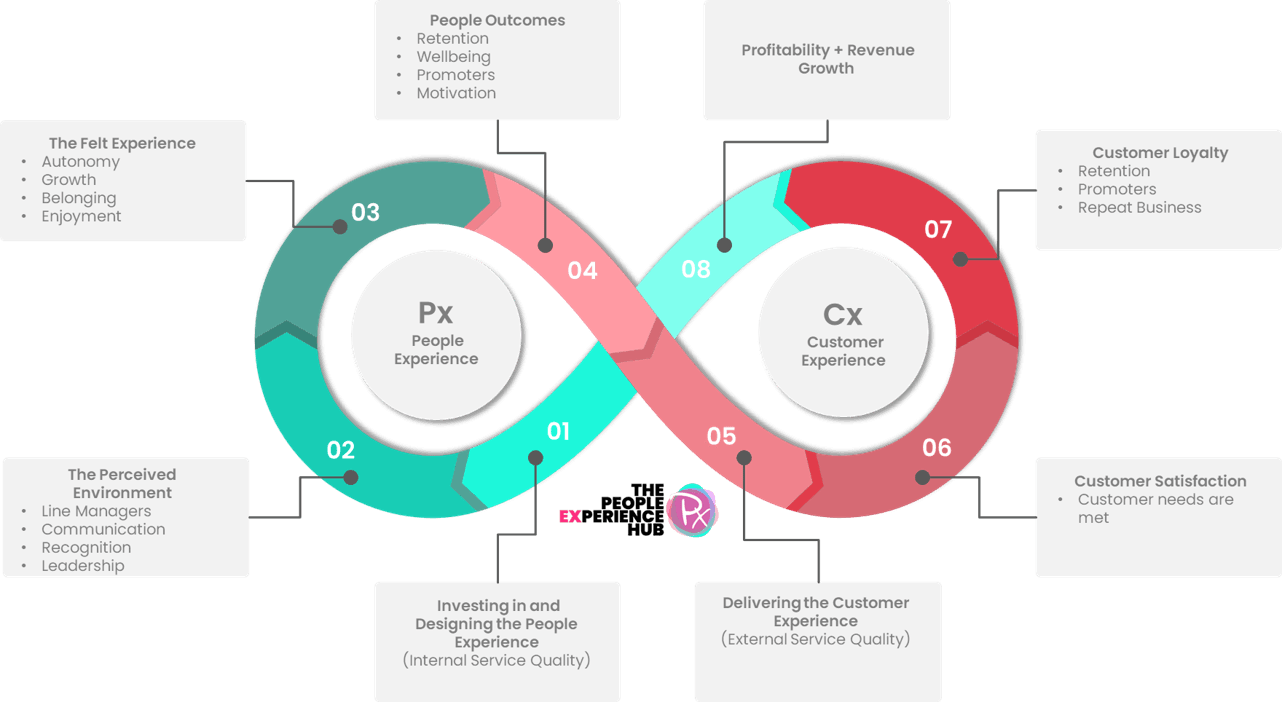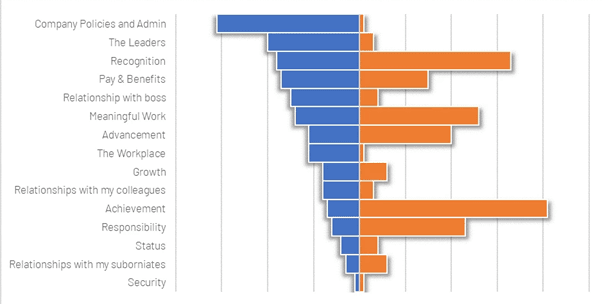How Employee Satisfaction is Better Business
We hear a lot about engaged employees being more productive and that motivated employees go over and above the basics that their role requires of them.
There appears to be a strong link between employee satisfaction and customer satisfaction that shows that there is a compelling business reason to invest in the people experience at work.
But if you want satisfied and motivated employees, you must design work with this in mind.
Employee Satisfaction and Business Results
The service profit chain has been around for a long time now and the principle is a simple one that when explained to most people they nod and say, “makes sense!”
It is a model based on getting the People Experience right, by design and driving employee motivation and satisfaction, which in turn drives business success.
In the service profit chain model, employee satisfaction leads to better outcomes for your people, which puts them in a better place to deliver the Customer Experience, which in turn leads to customer satisfaction, loyalty and ultimately revenue growth and profit (which can be invested back into the people experience).
The People Experience Hub take on this model is shown below:

What does the research tell us about the importance of employee satisfaction?
The importance of employee satisfaction has been researched many times; recently, Professor Alex Edmans from the London Business School looked at the Fortune 100 best companies to work for and found that firms with the best levels of employee satisfaction outperformed their peers by 2.3% to 3.8% at the stock market.
Alex says:
“It’s employee satisfaction that causes good performance, rather than good performance allowing a firm to invest in employee satisfaction.”
Research from Hoseong Jeon & Beomjoon Choi published in the Journal of Services Marketing in 2012 called “The Relationship between Employee Satisfaction and Customer Satisfaction” shows that employee satisfaction does have a positive impact on customer satisfaction.
But interestingly, customer satisfaction has limited or no impact on employee satisfaction.
This is especially meaningful for service industries like hospitality and retail, which invest a lot of time and money in designing the best customer experience possible.
The results suggest that the ES-CS relationship is unilateral rather than mutual. In particular, using dyadic data, this study found out employees’ job satisfaction leads to customer satisfaction but not vice versa.
People Experience by Design
One of our mantras here at The People Experience Hub is “People experience, by design,” and we help great companies do this by understanding how people who work there think about their work design.
This design covers the full spectrum of work, including job design, the tools they have to do their job well, their pay and benefits, how they interact with their peers, the workplace, and more.
Frederick Herzberg, an American psychologist, developed a well-documented two-pronged approach to thinking about satisfaction and motivation.
He realised that things that may help with employee satisfaction do not necessarily drive motivation as well and vice-versa.
The chart below shows in blue the elements that can cause dissatisfaction if poorly designed or implemented, and in orange, the elements that, if implemented well, can drive motivation. (The chart is ordered with Employee Satisfaction in mind)

We can see here that while having great company policies and administration is unlikely to motivate your people, their absence will certainly drive dissatisfaction.
The workplace is not a major motivator, but bad workplace design will always reduce levels of Employee Satisfaction.
The presence of great recognition will motivate staff, but the absence of recognition will reduce employee satisfaction.
Who are we designing work for?
We think that you should design work to work for most of your people, but we find more and more that companies have designed work not to be ‘people-centric’ but rather:
Task owner-centric design
You can see this if the phrase “It is easier for me if…” is used – we see this with expenses policies a lot! Rather than design it with the core users in mind it is designed with the finance process in mind.
Technology centric design
You can see this if the phrase “It is easier for the system if…” is used.
Customer-centric
Designed simply with just the customer in mind and ignoring the employee
Moving to People-centric design
there are several models that show that looking at design from the human user makes absolute sense, whether it is from process design, user design or ergonomic design the biggest driver has to be the human who will ultimately be performing the task, using the system or sitting in the chair.
This approach lets you design the experience with ALL people being considered from the employee to the processor, the customer and the consumer.
Human-centred design (HCD) considers all people's aspects when solving a problem or designing an experience.
Poor work design leads to dissatisfaction and demotivated people. Another issue we see is that the design happened long ago when the world was different. The failure of workplaces to adapt their design to new technology or other changes often means that while you may have started with your people in mind, this has now drifted and will translate into a poor people experience.
One of our clients reviews its processes every six months to ensure that they are still relevant to the continually changing world in which it operates.
Measuring the experience
Capturing feedback from your people at each stage of the employee journey allows you to understand what works and what needs work to make it better for your people (by design).
If you are looking to measure the experience of your employees at work, why not book a time with the team at The People Experience Hub to see how we can help you.
